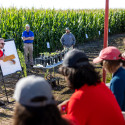Leading the effort to change personal health records
How do you manage your personal health information? From a shoebox? An expandable folder? Your doctor’s new Web-based software?
One of the nation’s few nurse-industrial engineers thinks both individuals and health systems can manage care better if they had better technology. And she’s leading an eight-year-long national effort to come up with a vision for personal health records that will go far beyond the current crop of ideas for helping people make decisions about their own health.
“We have to think bigger, and figure out how to take full advantage of the amazing new opportunities technology is providing,” says Patricia Flatley Brennan, who holds professorships in both the School of Nursing and College of Engineering. “A truly effective system of managing health information would not just make it easy to collect and store information like blood-pressure readings, medication lists or doctors’ instructions. It would be a very powerful tool to help people accomplish goals and manage chronic health problems.”
Brennan is the national program director of Project HealthDesign, which aims to create a new generation of personal health records. Originally funded by the Robert Wood Johnson Foundation in 2006, Project HealthDesign recently received an additional $5.3 million in funding to continue to explore Brennan’s vision. The award will allow the project to continue into 2012.
Brennan acknowledges that several health-information vendors are moving forward on various versions of electronic personal health records. But her vision, which derives from her role as a nurse and teacher of nurses, is both broader and more patient-centered.
“Project HealthDesign speaks to what is unique about nursing research, which strives to help people find ways to understand and manage their own health,” she says. “The tools that vendors have available now are mostly linked to a health care organization’s medical record or are disease-specific. What we seek to do is come up with tools and applications that can access all sorts of health information that work together to help people reach their health goals in a secure, integrated way.”
Imagine having a tool that keeps track of your accumulated health history — allergies, vaccinations, lab results, etc., that is collected during a typical clinical encounter — plus clinical information passively gathered from you — your blood pressure or glucose level, for example. Add to that what Project HealthDesign has identified as “observations of daily living” — things that you record yourself and have unique meaning for you: moods, pain or discomfort, events during the day.
Then imagine that the tool is able to integrate all your clinical and observational information, interpret the results and provide useful feedback on which you can act.
Consider a diabetic, who tries to carefully manage her food intake, exercise, medication and all of their effects on her blood sugar, sleep habits and mood. A useful personal health-information system would allow her to track all of those factors, give regular reports back to her with suggestions or warnings, and also alert a nurse or physician if her blood sugar was in a dangerous range.
“We all develop strategies for managing the different kinds of health information,” says Brennan. “Project HealthDesign is aimed at coming up with entirely new approaches using readily available technology and centered around the patient.”
During the first round of the project, researchers developed prototype tools that did much of the above. In its second round, researchers will focus on how the integrated information can be used in a clinical setting.
“By integrating what happens during a care visit with observations of daily living, caregivers and patients will have a more complete picture of how the patient manages his disease,” says Brennan. “We’ve already made a lot of progress in identifying barriers and finding ways to keep the information secure while still giving access to those who need it. Making this happen requires a lot of creative thinking by teams of folks with very different skills. By bringing together technology and health care professionals with patient-centered design experts, we are on the way.”
Brennan was recently selected to be one of five UW–Madison faculty whose research proposals will establish the Wisconsin Institute for Discovery (WID).
Her proposal for the Health Technology Design in the Living Environments Laboratory is aimed at accelerating the development of personal care diagnostic and therapeutic technology to support individuals and families in the detection, recognition and management of health problems.
“The Living Environments Laboratory research will help expand Project HealthDesign’s vision of engaging people in managing their health,” says Brennan, “by developing new devices and creative technologies to better understand health in everyday living.”
One focus will be to learn how individuals now access and manage health information at home, and then propose improvements. A second focus will be to find improvements in the many health-care technologies that are moving into the home, where they must be adapted to different circumstances and different users.




